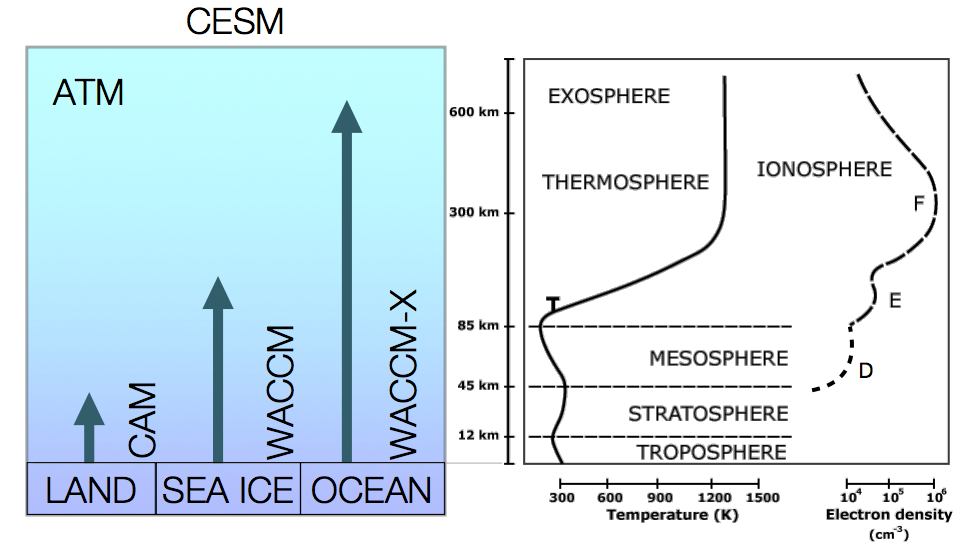
Model Description: The Whole Atmosphere Community Climate Model with thermosphere-ionosphere eXtension(WACCM-X) is a comprehensive numerical model that extends from the Earth’s surface to the upper thermosphere (~500 km). WACCM-X is part of the Community Earth System Model (CESM), an open-source community model. Developed at the National Center for Atmospheric Research (NCAR), CESM models the full Earth system, including the atmosphere, land surface, ocean, and sea ice. WACCM-X includes a comprehensive treatment of the chemical, physical, and dynamical processes necessary to study the entirety of Earth’s atmosphere, including the troposphere, stratosphere, mesosphere, thermosphere, and ionosphere. By simulating the whole atmosphere within a single modeling framework, WACCM-X enables the study of coupling mechanisms between different atmospheric regions. This includes the role of atmospheric waves, which originate in the lower atmosphere, on the driving of space weather.
An important aspect of WACCM-X is the capability to constrain the model with observations through the use of data assimilation. Data assimilation statistically combines observations with a numerical model, and aims to provide a better estimate of the state of the entire atmosphere than possible from either the observations or model alone. The improved representation of the atmosphere obtained with data assimilation enables more realistic simulations of the wave driven processes that are of interest to the WAVE DRIVE Center.
WAVE uses WACCM-X as a testbed for the development of a framework to improve the representation of the impact of lower atmospheric waves on the ITM. This includes further developing the high-resolution capabilities of WACCM-X to enable explicit simulation of both small- and large-scale waves, as well as their interaction, improved parameterization of primary gravity waves, parameterization of higher-order gravity waves, and development of advanced data assimilation techniques tailored to the ITM. These developments enable the WAVE team to address important scientific questions regarding the impact of the lower atmosphere on generating ITM variability, while also providing the community with advanced Earth System Modeling capabilities.
CESM: http://www.cesm.ucar.edu/
WACCM-X: http://www.cesm.ucar.edu/models/waccm-x/
HAO WACCM-X: https://www2.hao.ucar.edu/modeling/waccm-x
References: Liu, H.-L., Bardeen, C. G., Foster, B. T., Lauritzen, P., Liu, J., Lu, G., … Wang, W. (2018). Development and validation of the Whole Atmosphere Community Climate Model with thermosphere and ionosphere extension (WACCM-X 2.0). Journal of Advances in Modeling Earth Systems, 10, 381– 402. https://doi.org/10.1002/2017MS001232
Liu, H.-L., McInerney, J. M., Santos, S., Lauritzen, P. H., Taylor, M. A., and Pedatella, N. M. (2014), Gravity waves simulated by high-resolution Whole Atmosphere Community Climate Model, Geophys. Res. Lett., 41, 9106– 9112, doi:10.1002/2014GL062468.
Pedatella, N. M., Anderson, J. L., Chen, C. H., Raeder, K., Liu, J., Liu, H.-L., & Lin, C. H. (2020). Assimilation of ionosphere observations in the Whole Atmosphere Community Climate Model with thermosphere-ionosphere eXtension (WACCMX). Journal of Geophysical Research: Space Physics, 125, e2020JA028251. https://doi.org/10.1029/2020JA028251
Huba, J. D., & Liu, H.-L. (2020). Global modeling of equatorial spread F with SAMI3/WACCM-X. Geophysical Research Letters, 47, e2020GL088258. https://doi.org/10.1029/2020GL088258
Pedatella, N. M., Liu, H.-L., Marsh, D. R., Raeder, K., Anderson, J. L., Chau, J. L., et al. (2018). Analysis and hindcast experiments of the 2009 sudden stratospheric warming in WACCMX+DART. Journal of Geophysical Research: Space Physics, 123, 3131– 3153. https://doi.org/10.1002/2017JA025107


